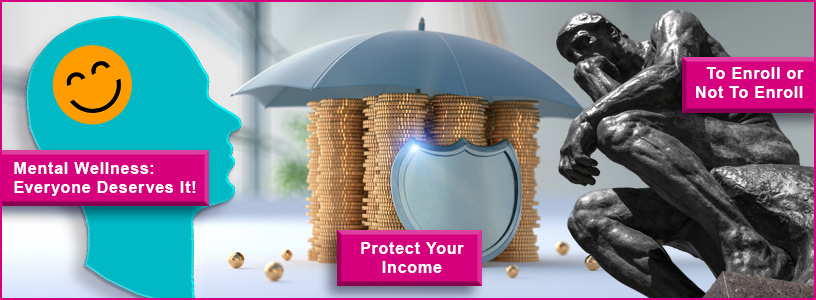MENTAL WELLNESS: Everyone Deserves It
Mental wellness is vital to a healthy and rewarding life. It is a state of well-being in which a person can cope with life’s stresses, work productively, and enjoy healthy relationships.
Mental illness, on the other hand, disrupts a person's thinking, mood, and behavior, and can cause problems in daily life, at work, and in relationships. Some examples of mental illness include depression, anxiety, PTSD, eating disorders and addictive behaviors.
Consider these sobering facts from the 2024 State of Mental Health in America report:
- 21% of adults are experiencing at least one mental illness. That’s roughly 50 million people. Half of them have not received any treatment.
- About 5% of adults have reported serious thoughts of suicide. Oregon has one of the highest rates of adults with mental illness and thoughts of suicide.
- Substance use disorder (heavy drinking and/or drug abuse) affects 25 million Americans. However, less than 7% are seeking treatment for this disorder.
People with a mental health or substance use disorder CAN and DO recover. In many cases, symptoms can be managed with a combination of medications and talk therapy.
The first step toward recovery is to ask for help. Talk to your doctor or health provider, meet with a counselor through the PPS EAP, or schedule an appointment with an in-network therapist. Please don’t wait to experience all that you can from a vibrant life. #NationalRecoveryMonth
Resources:
- SD-1 Trust Library: Mental Health Benefits Overview
- Providence Health: Substance Abuse Treatment
- Kaiser Permanente: Addiction and Recovery
LONG-TERM DISABILITY: Protect Your Income
None of us expects to become disabled, so most of us don’t think about the need for disability insurance to protect our income if we do become disabled...
...but did you know that 12% of the adult U.S. population suffers a long-term disability every year? And that on average, long-term disability leaves last almost three years? These disabilities are usually for non-work-related injuries and illnesses, such as neck and back pain, muscle and tendon disorders, and cancer.
While only half of Americans have long-term disibility (LTD) insurance coverage, 100% of eligible SD-1 Trust employees are automatically enrolled in a self-pay LTD insurance plan through The Standard. Here’s what that means for you: If you become disabled because of a covered injury, sickness or pregnancy, the Plan pays 60% of your pre-disability earnings, up to $6,000/month.
And that gives you something priceless: peace of mind.
To learn if you are eligible for self-pay Long-Term Disability coverage, go to sdtrust.com and click on Long-term Disability under My Benefits in the menu. Then select your union group and status and click GO!
Resources
- Your Trust Benefits: Long-Term Disability
- The Standard (the Trust’s LTD Carrier): What is Disability Insurance?
TO ENROLL OR NOT TO ENROLL: That is the Question
If you’re an Active Employee or Early Retiree, Open Enrollment takes place October 7-25. Watch for an Open Enrollment packet to arrive in your mail by October 7. Be sure to read it to understand your options and any updates for the 2025 Plan Year.
And come to the Benefits Fair (Wednesday, Oct. 9, 3:30-5:30 p.m., PEC Building Foyer), where you can talk to Plan representatives about your benefit options to help you decide what you’d like to do with your benefit selections for the 2025 Plan Year. While you’re there, get a free seasonal flu shot, win a door prize, and pick up giveaways!
Do you need to enroll?
- Are you already enrolled? If you don’t want to make any changes (or add or drop dependents), you don’t need to do anything. Your selections (except FSAs) will automatically roll over unless you change them by enrolling during Open Enrollment.
- Not yet enrolled? If you want coverage, you must enroll during Open Enrollment. If you don’t enroll, you won’t have coverage during the 2025 Plan Year (January 1–December 31, 2025).
- Want to save with an FSA? You must enroll to have a Flexible Spending Account in 2025. FSAs do NOT roll over (available to Active Employees only).
- How to enroll? Beginning October 7, look for your Open Enrollment packet in your mail or go to sdtrust.com where you can also get all of the details.
- Active Employees: Go to selfservice.pps.net and log in using your PPS username and password.
- Early Retirees: Complete the enrollment form and turn it into the Administrative Office.
Resources:
Watch our short videos and be prepared to choose the best benefit options for yourself and your family:
- Open Enrollment—What’s the Big Deal? Make the most of this once-per-year opportunity.
- Choose Your Health Plan: HMO, PPO, or EPO…what’s the difference?
- Life Insurance & Accidental Death and Dismemberment Insurance: Discover how these benefits protect you and your family financially if you die or are permanently injured.
- How to Get Answers for Your Trust Benefits Questions: Know where to go to get answers fast.


